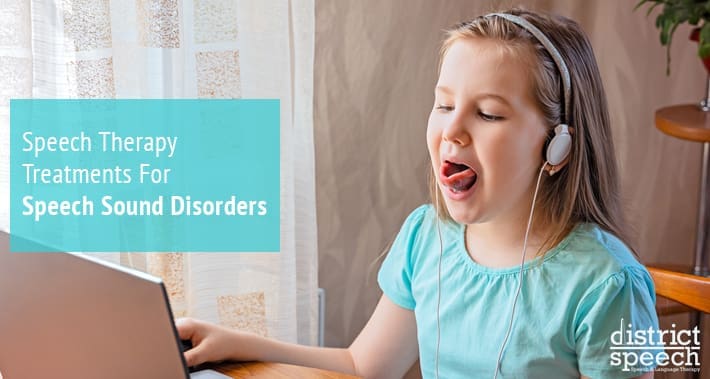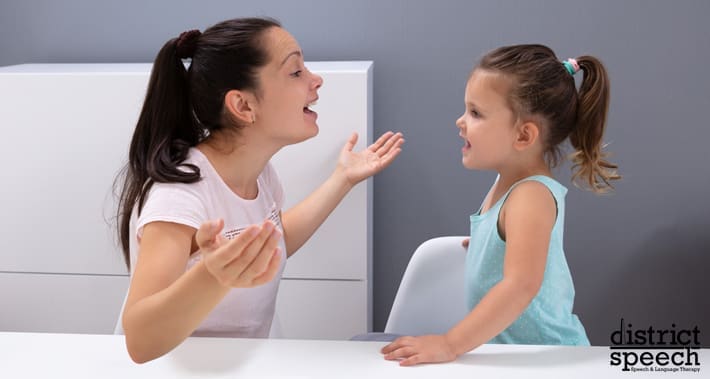
A speech sound disorder is an umbrella term used to describe any difficulty with speech sounds.
There are many different types of speech sound disorders, and their causes may differ from one another.
Speech sound disorders can occur in both adults and children.
In fact, statistics on speech sound disorders suggest that approximately 9.4 million adults in the US have a speech sound disorder, and 1 in 12 US children have a speech sound disorder.
There are many warning signs for speech sound disorders in children.
Early intervention of speech sound disorders is key to reducing the impact on every day functioning.
If you’re concerned you or your child may have speech sound disorder, the next step is to see a speech language pathologist to be evaluated for a speech sound disorder.
Your therapist will create a custom program designed to help you or your child improve.
If you’re wondering “are there good options for speech therapist for children?”
We humbly suggest our Washington DC speech therapy clinic, District Speech and Language Therapy.
We also have options for adults as well.
But first, let’s take a closer look at speech sound disorders.
What Is A Speech Sound Disorder?
Any difficulty with perception, motor production, or phonological representation of speech sounds and speech segments can be considered a speech sound disorder.
There are two main types of speech sound disorders that differ depending on their cause.
These are called organic speech sound disorders and functional speech sound disorders.
Signs and Symptoms Of Speech Sound Disorders
There are many different signs and symptoms of speech sound disorders.
These signs and symptoms involve errors in speech.
Your child may not be hitting the key speech related developmental milestones in children.
These errors in speech can be grouped into the following categories:
- Substitutions, where one or more sounds are substituted, for example “thing” for “sing”
- Additions, where one or more extra sounds are added into a word, for example “buhlack” for “black”
- Deletions, where some sounds are deleted, for example “poon” for “spoon”
- Distortions, where sounds are changed or altered, for example a lateral “s”
- Syllable errors, where weak syllables are deleted, for example “tephone” for “telephone”
If you or your child display any of the following signs and symptoms, our team of therapists can help.
What Causes Speech Sound Disorders?
The cause of your speech sound disorder determines what type it is.
Your speech sound disorder is organic if it is caused by an underlying cause in your body.
These underlying issues that cause speech sound disorders can be neurological, structural or perceptual conditions.
If you experience the following, you would have an organic speech sound disorder:
- A speech disorder related to cleft palate or cleft lip
- Hearing impairment
- Childhood apraxia of speech
The causes of organic speech sound disorders can be broken down as follows:
- Neurological: dysarthria and childhood apraxia of speech
- Structural: cleft palette, or other damage of the mouth
- Perceptual: hearing loss or impairment
These impairments may impact your child’s development in a number of different ways.
RELATED: Getting Familiar With Speech Disorders: Dysarthria
You or your child may be at a higher risk for speech sound disorder due to:
- A developmental disability, like Autism Spectrum Disorder
- A genetic disorder, like Down syndrome
- A nervous system issue like cerebral palsy or a head injury,
- Being a male
- Having a parent with low education
- Having a lack of support for learning
In fact, studies show that boys are 2 times more likely to develop a speech sound disorder than girls are.
For functional speech sound disorders, the exact cause is unknown.
So, your speech sound disorder is functional if it occurs with no underlying cause.
Idiopathic is another term for a disorder with unknown cause.
Functional speech sound disorders include disorders related to the articulation and phonology of speech production.
An articulation disorder involves errors in speech production, where a person adds letters, distorts sounds, or omits letters in speech.
If your child has an articulation disorder, they may benefit from some articulation games to build a child’s language and articulation skills.
RELATED: Articulation Disorder: When Is It Baby Babble And When Is It A Problem?
Phonological disorders are errors that impact more than one sound in speech.
An example of this would be using two syllables to simplify a word, such as “baba” instead of “bottle.”
How Do We Test For Speech Sound Disorders?
There are different red flags in speech and language development that indicate when you should take your child to a speech and language pathologist.
If you’re concerned your child has a speech sound disorder because they are showing some of these red flags, the first thing you should do is take them to a speech therapist.
Your child’s speech therapist will test for a speech sound disorder during their comprehensive evaluation in order to fully understand your child’s needs.
They’ll check your child’s oral motor functioning, which includes their range of motion and their general oral strength.
Your child’s speech therapist will also check for any structural challenges to their speech, including facial symmetry.
Finally, they’ll check your child’s language understanding and speech production.
Your child’s speech therapist will also take into account typical developmental errors that may come up during the test in order to differentiate unusual errors.
How Does Speech Therapy Treat Speech Sound Disorders?
There are many strategies your child’s speech therapist can employ to help your child’s speech sound disorder.
The type of strategy they use will depends on the type of disorder your child has.
For this reason, their treatment will be personalized in order to achieve the best results.
Let’s find out more about some common types of speech therapy for speech sound disorders, and how speech therapy words in kids.

1. Phonological Contrast
A phonological contrast approach is used if your child has any phonological errors.
The goal is to improve the contrast in your child’s speech so that they speak clearer, pronouncing each sound correctly.
One example of this is to have your child focus on the differences between similar sounding words and phrases, like “ray” vs. “day” for example.
2. Core Vocabulary Approach
The core vocabulary approach is considered for children with inconsistent speech sound production who also resist traditional therapy approaches.
A list of common words is developed and your child is tested on these words each week.
The goal is for them to practice these words until they can consistently produce them.
3. Contextual Utilization
Contextual utilization is an approach that considers that speech sounds are produced in connected speech.
So, it focuses on using context in order to help your child produce the correct sound.
It typically works best for children who are inconsistent in their sound production.
Your child may need the context to help with consistency so that they will be able to later produce that sound in new contexts.
4. Cycles Approach
The cycles approach targets children who have very unintelligible speech, extensive deletions, some substitutions, and a restricted use of consonants.
It breaks up their treatment into cycles ranging from 5 to 16 weeks.
Each cycle focuses on one or more challenges, and the goal is to stimulate the target, not master it.
This way, the program will repeat until your child begins to incorporate the correct speech sounds into their everyday speech.
5. Complexity Approach
The complexity approach uses complex linguistic prompts to related, untreated targets of speech sound production.
The goal is to have your child grow familiar with these related targets.
6. Other Treatment Options
Finally, some other treatment options for speech sound disorders include:
- Metaphon therapy
- Distinctive feature therapy
- Naturalist speech intelligibility intervention
- Non speech oral motor therapy
- Speech sound perception training
Book Your Appointment With District Speech Today
As you can see, there’s a wide variety of speech therapy treatments available if your child has a speech sound disorder.
The sooner you can start their treatment, the better because they will improve faster and there will be less time for bad speech habits to get ingrained.
This is why early intervention speech therapy is so important.
The District Speech teem is ready to help with that.
We also have speech therapists available for adults that are experiencing speech sound disorders.
Book your appointment with District Speech today.
1300 I St NW, Suite 400 E,
Washington, DC 20005
- https://g.page/districtspeech
District Speech and Language Therapy specializes in speech therapy, physical therapy, and occupational therapy solutions, for both children and adults, in the Washington D.C and the Arlington Virginia areas.